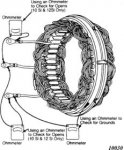Mikebones1111
Recruit
- Joined
- Feb 24, 2015
- Messages
- 2
Hello I have a 1986 140hp Johnson V4 (VRO removed)
My charging system seems to be weak when motor is running the volt gauge sits at 12v and that is confirmed by multimeter. I talked to a Power sports mechanic he asked me some questions if I had any melted plastic dripping from the stator windings which I do not as far as I can tell. He then recommended I try replacing the regulator/rectifier before replacing the stator. He said the previous owner could have fried it by jumping it from a running car. I replaced it and I saw only a slight gain in the voltage 12.5-13V when running not the 14+v I think I should be getting (If someone could confirm that because that is just a guess).
I am mechanically inclined and do most of my own work but another mechanic friend said it might be easier to pay to have the stator replaced. Has any one replaced their stator would you recommend doing it yourself again or paying to have it done. Can I check anything else to see if it solves the problem before diving into the stator?
Thank you,
My charging system seems to be weak when motor is running the volt gauge sits at 12v and that is confirmed by multimeter. I talked to a Power sports mechanic he asked me some questions if I had any melted plastic dripping from the stator windings which I do not as far as I can tell. He then recommended I try replacing the regulator/rectifier before replacing the stator. He said the previous owner could have fried it by jumping it from a running car. I replaced it and I saw only a slight gain in the voltage 12.5-13V when running not the 14+v I think I should be getting (If someone could confirm that because that is just a guess).
I am mechanically inclined and do most of my own work but another mechanic friend said it might be easier to pay to have the stator replaced. Has any one replaced their stator would you recommend doing it yourself again or paying to have it done. Can I check anything else to see if it solves the problem before diving into the stator?
Thank you,




















